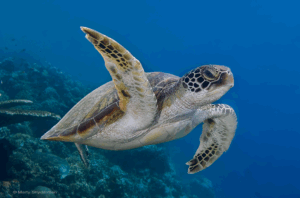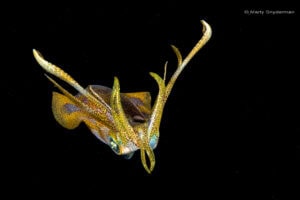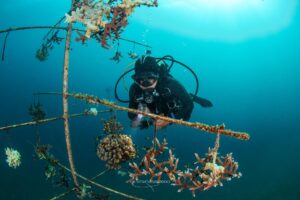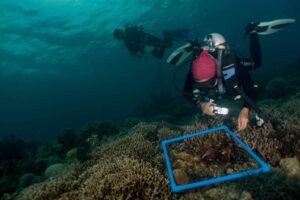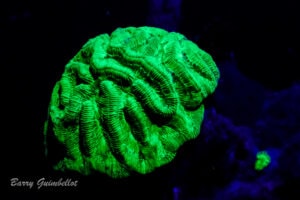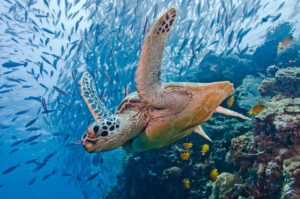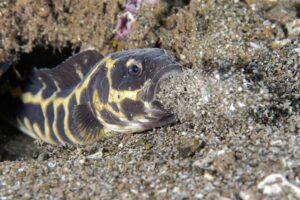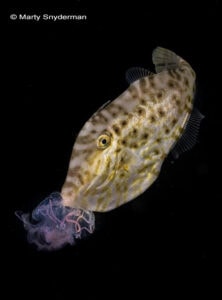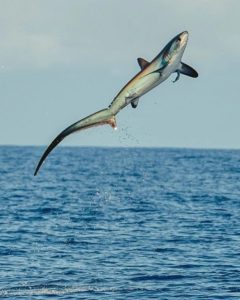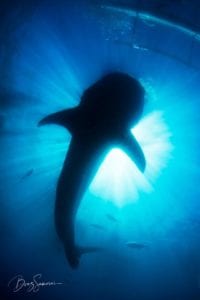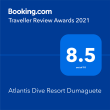[vc_row bg_style=”stretch”][vc_column][vc_column_text]By Marty Snyderman
Some diving stories sound like exactly that. Stories. Tall tales. I suppose it’s fair to say that sea stories are as much a part of diving as scuba tanks and regulators. In many instances trying to separate fact from fiction proves to be challenging even for seasoned divers.
Frankly, it won’t surprise me if some people, even a lot of people, suspect that what I am going to share with you about a couple of dive at a single site in Dumaguete is one of those greatly embellished sea stories. But you have my word, it is not. This sea story sticks to the facts.
I spent most of this past September and early October diving from our resort in Dumaguete. When I arrived, one of the animals I hoped to see and photograph during my visit was a blue-ringed octopus. Naturally, I was excited to learn that there had been a number of blue-ringed encounters at a site named Punta during the previous week, and I eagerly looked forward to giving the area a try.
Punta is only a five-minute boat ride from the resort. It is a point, as its name suggests, and it is sometimes prone to stronger currents than other nearby sites. The bottom is a mix of sand and rubble, and like many muck sites, upon first glance it is easy to think “why dive here?” But like so many great muck sites at both Dumaguete and Puerto Galera, it would be a mistake to judge this book by its cover.
On our first dive, our guide Harnold located the first octopus about the same time I cleared my ears. Harnold spotted a coconut octopus poking its head out of a collection of shells. Everyone took a good look and captured some images.
By the time we were finished photographically sharing the coconut octopus Harnold and another diver had located an undescribed species of octopus and a small flamboyant cuttlefish that was actively feeding as it moved along the sea floor. I love to try to photograph animal behavior, so I followed the cuttlefish. I followed it right to a blue-ringed octopus that was perched on top of a small rock.
This was already getting crazy. We had only been underwater for 20 minutes or so, and already we had seen four species of cephalopods. I stayed with the blue-ringed as it made its way across the sea floor until I heard someone banging on their tank. I turned around and there was Harnold, signaling us to swim to him. As we got close, Harnold signaled for us to stop, and then to slowly approach. Then, he turned and pointed to the sea floor where a mimic octopus was resting.
It’s easy to get confused, or be uncertain about making a positive identification, when trying to decide if an octopus is a mimic or a wonderpus. As far as I know, the best way to make the determination is to look for the thin, continuous white stripe located toward the bottom of the arms of mimics. In this case, with the way the octopus was posed, it was easy to see the white stripes and to know we were looking at a mimic. That was the last of our cephalopod encounters on that day.
But we weren’t done yet. All of us were so excited about our day that we unanimously decided to go back to Punta the following day. On our second day, we quickly added a poison ocellate octopus that was sitting atop a rock while showing off one bright blue circular spot on each side of its body. Only moments later we spotted a pygmy cuttlefish in front of a crinoid.
Not long after those sightings Genie came across a wonderpus, and it put on a great show as it changed its colors from brown and white to orange and white while waving its arms up into the water column.
To this point, we had seen eight species of cephalopods. You simply cannot ask for more. I certainly didn’t, and I can’t imagine that anyone else felt like it would be a reasonable request. But toward the end of our second dive, as we made our way up the slope, we came across a broadclub cuttlefish, one of the more commonly encountered species of cephalopods, hovering over a sandy patch.
On the boat ride back to the resort we referred to the site as Cephalopod City, and while I am sure the name Punta will remain on the maps, it was Cephalopod City to all of us for the rest of our trip.[/vc_column_text][/vc_column][/vc_row][vc_row][vc_column][vc_masonry_media_grid grid_id=”vc_gid:1585932256424-75241959-90cf-9″ include=”10311,10310,10309,10308,10307,10306,10305,10304,10303″][/vc_column][/vc_row]


